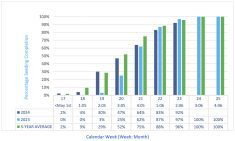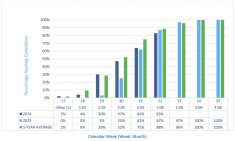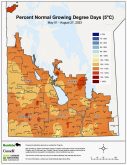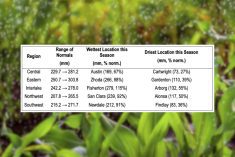Last year’s pest problems may give an idea of what to be on watch for next season.
The insect summary for 2017 is in, and Manitoba Agriculture entomologist John Gavloski says the report may give producers valuable insight when planning scouting and, in some cases, rotations.
Aphids unknown
Not all insects carry over in the same way, if at all.
Last year’s aphid issues may mean little next season, for example, since Gavloski notes most of the province’s pest aphids do not overwinter here.
Read Also

Manitoba canola industry has new frontiers
Canola oil is still the main priority for the sector, but canola meal is increasingly the subject of research looking for new markets and uses for the oilseed’s byproduct.
“We could have a bad population one year and then the next year nothing much blows in and they’re not an issue,” he said. “Something like bertha army worm or cutworms, they sort of build up and you get a few bad years and then they drop off with natural enemy control and weather-related (die off), but they’re insects that overwinter here. With something that blows in, it’s totally erratic.”
Aphids were a problem for a wide range of crops last year. Both English grain aphids and bird cherry-oat aphids reached their economic threshold in cereals. The latter brought disease issues to the central region after several fields were marked with barley yellow dwarf virus, a pathogen carried by the insect. In pulses, pea aphids were a wide-ranging problem in the northwest, Interlake, central and southwest parts of the province. The same aphid problems led to herbicide applied to soybean fields in central Manitoba soybean. Potatoes also reported high levels of the pest.
Lack of moisture contributed to aphid damage, Gavloski said.
Manitoba, along with Saskatchewan and Alberta, struggled with drier-than-average conditions through summer.
“The plants are already stressed and the aphids are feeding on sap, so it’s kind of a further stress on the plant,” he said, adding that heavy rains can also drown out aphids and encourage fatal fungal infections in the insects.
The same areas saw high populations of lady beetles. Unlike their prey, the predatory insect does overwinter in Manitoba. Lady beetle populations are expected to start 2018 on a high as a result, although Gavloski says those populations may adjust if aphid numbers drop.
“That being said, if you have a huge overwintering population, if you get some of these low to moderate aphid populations blowing in, there’s a lot of hungry predators waiting for them,” he added.
Worms and flea beetles
Not all of 2017’s problem insects blew in on the wind. Flea beetles, one of canola’s most common scourges, caused widespread concern in early 2017. Some fields in central Manitoba needed to be reseeded because of the pest, despite the common use of seed treatment.
“Slow emergence and growth due to cool weather conditions and dry soil increased injury from flea beetles in some areas,” the report reads. “Significant stem feeding by flea beetles was noticed in some fields.”
Last year also saw an upswing in worms. Cutworms were sprayed out of sunflower fields, dry beans, corn, canola and soybeans in central Manitoba, while northwest Manitoba struggled with the same pest in hemp, grains, canola, peas and lentils.
“They’re such generalists that it’s hard to plan a rotation around them because they eat so many things. You just have to be out there scouting early and keeping an eye on things,” Gavloski said.
Flea beetles also aren’t affected much by the crop rotation.
“They’re very mobile,” Gavloski said. “So, again, rotation’s not likely to have a huge impact.”
Rotation may have more effect on bertha army worm, since they overwinter in the same field they feed and prefer canola.
Bertha army worm cropped up this year in western Manitoba as the calendar switched into July. Traps near Benito reported counts as high as 605 worms over the summer while traps in both the northwest and southwest of the province typically ranged from 300-400.
Canola in the west and central regions was also under threat from diamondback moth from mid-July on. Traps in Minitonas approached 200 worms, while The Pas claimed 129 and all other regions fell short of those levels.
“In some areas there was not a lot of leaf material on the canola because of the dry weather, which may have resulted in larvae moving onto the pods early,” the annual report read.
Thistle caterpillars gave rise to concern in soybeans. The visible webs from the larvae led some producers in the central region to spray.
Potato problems
There have been yet more reports of Colorado potato beetles with no fear of pesticide.
Titan- or Aspire-treated fields still saw a pervasive population of the insect in July and later in the season.
“This class of chemistry does not appear to be performing as well as it used to in a few locations,” Manitoba Agriculture noted. “Delegate insecticide was used in many instances as foliar application.”
“Make sure that you rotate your chemical families,” Gavloski said. “Which is almost hard to do because the neonicotinoid seed treatment has become almost a very standard way of controlling Colorado potato beetle, but if you’re doing that year after year after year, it’s almost inevitable that the beetles will develop resistance.”
The provincial report noted a host of smaller, less widespread concerns, including European corn borer in potatoes and corn, spider mites in soybeans, alfalfa weevil leading to early cuts in some alfalfa fields, lygus bugs in northwestern canola fields, thrips in barley and army worms in select fields in the east. In the bin, producers are still fighting with rusty grain beetle and a surprise northern emergence of lesser grain borer, a pest that normally stays farther to the south, but that Gavloski guesses was brought in thanks to strong southerly winds.
The full report can be found on the Manitoba Agriculture website.




















